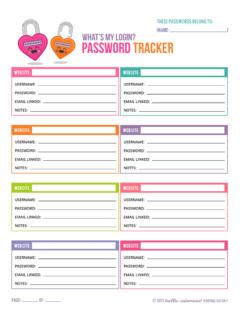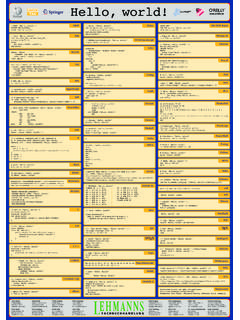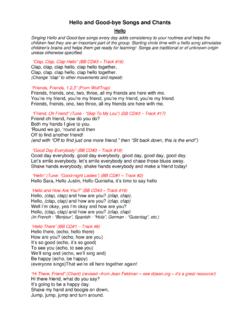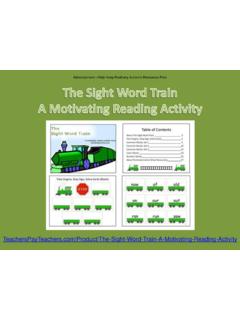Transcription of Hello from my Habitat! - VDOE
1 Science Enhanced Scope and Sequence Grade 4 virginia department of education 2012 1 Hello from my habitat ! Strand Living Systems Topic Investigating the habitats Primary SOL The student will investigate and understand how plants and animals, including humans, in an ecosystem interact with one another and with the nonliving components in the ecosystem. Key concepts include b) organization of populations, communities, and ecosystems and how they interrelate; d) habitats and niches. Related SOL The student will demonstrate an understanding of scientific reasoning, logic, and the nature of science by planning and conducting investigations in which a) distinctions are made among observations, conclusions, inferences, and predictions; e) predictions and inferences are made, and conclusions are drawn based on data from a variety of sources; m) current applications are used to reinforce science concepts.
2 Background Information A habitat is a place where an organism lives. Usually an organism s habitat must be able to provide food, space, water, and shelter. The dominant plant form or a physical characteristic, such as forest or wetland, often characterizes a habitat . Some species can live only in very specific habitats and nowhere else; for example, the panda can only live in certain forests of China and Nepal because the food they eat and the climate they need are found only in those areas. Other organisms, such as squirrels, are well adapted for several habitats. Squirrels can live in deciduous forests and coniferous forests, as well as in suburbs and cities. Plants and climate are the two major determinants of an organism s habitat .
3 Materials One small stuffed or plastic animal per student Large opaque plastic bag Pictures of habitats Reference materials such as trade books, encyclopedias, or Internet sources habitat names written on slips of paper Copies of the attached Hello from My habitat ! data sheet Water Vocabulary populations, communities, ecosystems, habitats, niches, living, nonliving Science Enhanced Scope and Sequence Grade 4 virginia department of education 2012 2 Student/Teacher Actions (what students and teachers should be doing to facilitate learning) Introduction 1. Ask students to think of natural areas near their home or school. They may name examples such as a park, a river, or a forest.
4 2. List the natural areas on the board. 3. Explain that these areas are all habitats and that habitats are the special places where organisms live. 4. Ask the students to think about what is common with all of the habitats listed on the board. 5. Add students to brainstorm any other habitats and add them to the list on the board. 6. Ask the students to name organisms that might live in each habitat . List the organisms under the correct habitat heading as students name them, keeping in mind that some organisms may be able to live in more than one habitat . If students are struggling to come up with ideas, use some of the stuffed animals to stimulate discussion. 7. Explain to the students that they are going to get a chance to learn more about an organism and the habitat in which it lives.
5 Procedure 1. Place the pictures of different habitats on the walls or on the floor around the room. 2. Allow each student to pull one animal from the plastic bag. Have students stand by the picture of the habitat in which they think their animal lives. 3. Have each student tell what kind of animal he or she picked and describe the habitat where that animal lives. Correct any incorrect placements or misconceptions. 4. Have students go to their desks with their animals, and give them copies of the Hello from My habitat ! data sheet. Allow students to use the available reference materials to fill in the spaces on their sheets. Circulate among the students as they complete their charts to help clear up any misconceptions or to offer other assistance.
6 5. Once the students have filled in their charts and you have checked them for accuracy, have each student write a letter to an animal in another of the classroom habitats. Encourage the students to make their letters interesting and entertaining, as well as informational, drawing from the facts recorded on their data sheets. 6. After the letters are written, have the students fold them in half and address the letter with the animal s name and appropriate habitat , for example: Grey Squirrel Third Oak Tree on the Right East Forest. 7. Deliver the letters to the appropriate habitats, and give the students time to read them. Have students share letters with the class.
7 Science Enhanced Scope and Sequence Grade 4 virginia department of education 2012 3 Conclusion 1. Ask students to name various habitats in which humans live and to give examples of the adjustments some people make in order to survive in some of Earth s more extreme habitats. 2. Ask students where they would live in their habitat ( , squirrels live in trees in the forest habitat ). Assessment Questions o How do you know an animal lives in a certain habitat ? o What are the necessary parts of every habitat for animals? Journal/writing prompts o Choose a different animal than the one you researched. Write about the habitat and the day in the life of the animal. o Have students describe the habitat in which they live.
8 Why is their habitat suitable for their needs? Other o List the animals used during the activity and the habitats in which they belong. Have students match the animals with the appropriate habitats. o Assess the accuracy of the information on the data charts and in the letters written. Extensions and Connections (for all students) Conduct the same activity, using pictures of other organisms, such as plants. Let students make a bulletin board with the letters and pictures they have drawn of their animals. Have another class complete the activity, writing letters to your class. Strategies for Differentiation Create a check list of different animals or plants that the students might see in a habitat ( , trees, water, rocks, birds, grass).
9 To help students create their letters to another animal, have a question guide sheet. Students can draw a picture of a habitat they have seen. Provide students with a photo of a habitat and have them draw animals and plants that they might see in that habitat . Give students photos, plants, and animals that they can glue into the correct habitat . Create a sort using technology ( , interactive whiteboards). Science Enhanced Scope and Sequence Grade 4 virginia department of education 2012 4 Hello from My habitat ! Name: Date: Organism s name: _____ Diet Appearance Predators Number of young habitat Hello from My habitat ! Name: Date: Organism s name: _____ Diet Appearance Predators Number of young habitat
















